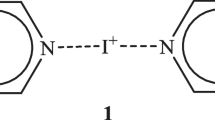Abstract
We have analyzed by means of Density functional theory calculations the nuclear quadrupole coupling constants of a range of gold, antimony, platinum, niobium and tantalum compounds. The geometrical parameters and halogen nuclear quadrupole coupling constants obtained by these calculations substantially corresponded to the data of microwave and nuclear quadrupole resonance spectroscopy. An analysis of the quality of the calculations that employ pseudo-potentials and all-electron basis sets for the halogen compounds was carried out. The zero order regular approximation (ZORA) method is shown to be a viable alternative for the calculation of halogen coupling constants in molecules. In addition, the ZORA model, in contrast to the pseudo-potential model, leads to realistic values of all metal nuclear quadrupole coupling constants. From Klopman’s approach, it follows that the relationship between the electrostatic bonding and covalent depends on the nature of the central atom. The results on Mössbauer chemical shifts are also in a good agreement with the coordination number of the central atom.
Similar content being viewed by others

References
Bancroft, G.M.: Moessbauer Spectroscopy. An Introduction for Inorganic Chemists and Geochemists. Wiley, New York (1973)
Parish, R.V.: Correlation of Moessbauer isomer’s shifts and quadrupole coupling constants with electron configurations for tin, antimony, tellurium, and iodine. Coord. Chem. Rev. 42, 49–58 (1982)
Townes, C.H., Dailey, B.P.: Determination of electronic structure of molecules from nuclear quadrupole effects. J. Chem. Phys. 17, 782–796 (1949)
Poleshchuk, O.Kh., Shevchenko, E.L., Branchadell, V., Lein, M., Frenking, G.: Energy analysis of the chemical bond in group IV and V complexes: a density functional theory study. Int. J. Quant. Chem. 101, 869–877 (2005)
Poleshchuk, O.Kh., Koput, J., Latosinska, J., Nogaj, B.: Ab inito study of the bonding and nuclear quadrupole coupling in the Py–ICl complex. J. Mol. Struct. 513, 29–34 (1999)
Becke, A.D.: Density-functional thermochemistry. III. The role of exact exchange. J. Chem. Phys. 98, 5648–5652 (1993)
Lee, C., Yang, W., Parr, R.G.: Development of the Colle-Salvetti correlation-energy formula into a functional of the electron density. Phys. Rev. 37B, 785–789 (1988)
Stevens, P.J., Devlin, F.J., Chablowski, C.F., Frisch, M.J.: Ab initio calculation of vibrational absorption and circular dichroism spectra using density functional force fields. J. Phys. Chem. 98, 11623–11627 (1994)
Frisch, M.J., Trucks, G.W., Schlegel, H.B., Gill, P.M.W., Johnson, B.G., Robb, M.A., Cheeseman, J.R., Keith, T., Petersson, G.A., Montgomery, J.A., Raghavachari, K., Al-Laham, M.A., Zakrzewski, V., Ortiz, J.V., Foresman, J.B., Closlowski, J., Stefanov, B.B., Nanayakkara, A., Challacombe, M., Peng, C.Y., Ayala P.Y., Chen, W., Wong, M.W., Andress, J.L., Replogle, E.S., Gomperts, R., Martin, R.L., Fox, D.J., Binkley, J.S., Defress, D.J., Baker, J., Stewart, J.P., Head-Gordon, Gonzales, C., Pople, J.A.: Gaussian 98, Revision A. Gaussian, Inc., Pittsburg, PA (1998)
Parr, R.G.,Yang, W.: Density-functional Theory of Atoms and Molecules. Oxford University Press, Oxford (1989)
ADF2005.01; SCM, Theoretical Chemistry. Vrije Universitat, Amsterdam. http://www.scm.com (2008)
te Velde, G., Bickelhaupt, F.M., Baerends, E.J., Fonseca-Guerra, C., van Gisbergen, S.J.A., Snijders, J.G., Ziegler, T.: Chemistry with ADF. J. Comput. Chem. 22, 931–967 (2001)
Fortunelli, A., Germano, G.: Ab initio study of the intra- and intermolecular bonding in AuCl(CO). J. Phys. Chem., A 104, 10834–10841 (2000)
Huber, K.P., Herzberg, G.: Molecular Spectra and Molecular Structure Constants of Diatomic Molecules. Van Nostrand, New York (1979)
van Lenthe, E., Baerends, E.J., Snijders, J.G.: Relativistic regular two-component Hamiltonians. J. Chem. Phys. 99, 4597–4610 (1993)
van Lenthe, E., Baerends, E.J., Snijders, J.G.: Relativistic total energy using regular approximations. J. Chem. Phys. 101, 9783–9792 (1994)
van Lenthe, E., Snijders, J.G., Baerends, E.J.: The zero-order regular approximation for relativistic effects: the effect of spin-orbit coupling in closed shell molecules. J. Chem. Phys. 105, 6505–6516 (1996)
van Lenthe, E., van Leeuwen, R., Baerends, E.J., Snijders, J.G.: Relativistic regular two-component Hamiltonians. Int. J. Quant. Chem. 57, 281–293 (1996)
van Lenthe, E., Ehlers, A.E., Baerends, E.J.: Geometry optimizations in the zero order regular approximation for relativistic effects. J. Chem. Phys. 110, 8943–8953 (1999)
Evans, C.J., Gerry, M.C.L.: The pure rotational spectra of AuCl and AuBr. J. Mol. Spectrosc. 203, 105–117 (2000)
Evans, C.J., Lesarri, A., Gerry, M.C.L.: Noble gas–metal chemical bonds. Microwave spectra, geometries, and nuclear quadrupole coupling constants of Ar–AuCl and Kr–AuCl. J. Am. Chem. Soc. 122, 6100–6105 (2000)
Walker, N.R., Gerry, M.C.L.: Microwave spectra, geometries, and hyperfine constants of OCAgX (X = F, Cl, Br). Inorg. Chem. 41, 1236–1242 (2002)
Buslaev, Yu.A., Kravchenko, E.A., Kolditz, L.: Nuclear quadrupole resonance in inorganic chemistry. Coord. Chem. Rev. 82, 9–231 (1987)
Sternheimer, R.M.: Effect of the atomic core on the nuclear quadrupole coupling. Phys. Rev. 95, 736–750 (1954)
Bowen, L.H., Long, G.G.: Antimony(V) orbital populations from antimony-121 Moessbauer data. Inorg. Chem. 15, 1039–1044 (1976)
Friedt, J.M., Shenoy, G.K., Burgard, M.: Mössbauer spectroscopy of 121Sb in adduct complexes of antimony pentachloride. J. Chem. Phys. 59, 4468–4473 (1973)
Poleshchuk, O.Kh., Latosinska, J.N., Yakimov, V.G.: Quadrupole coupling constants and isomeric Moessbauer shifts for inorganic compounds and complexes containing elements from period V calculated by ab initio methods. Phys. Chem. Chem. Phys. 2, 1877–1882 (2000)
Dickson, D.P.E., Berry, F.J.: Mössbauer Spectroscopy. Cambridge University Press, Cambridge (1986)
Frenking, G., Wichamann, K., et al.: Towards a rigorously defined quantum chemical analysis of the chemical bond in donor–acceptor complexes. Coord. Chem. Rev. 238–239, 55–82 (2003)
Klopman, G.: Chemical reactivity and the concept of charge- and frontier-controlled reactions. J. Am. Chem. Soc. 90, 223–234 (1968)
Pearson, R.G.: Chemical Hardness. Wiley-VCH, Weinheim (1997)
Author information
Authors and Affiliations
Corresponding author
Rights and permissions
About this article
Cite this article
Poleshchuk, O.K., Branchadell, V., Ritter, R.A. et al. Quadrupole coupling constants and isomeric Mössbauer shifts for halogen-containing gold, platinum, niobium, tantalum and antimony compounds. Hyperfine Interact 181, 27–36 (2008). https://doi.org/10.1007/s10751-008-9698-5
Published:
Issue Date:
DOI: https://doi.org/10.1007/s10751-008-9698-5


